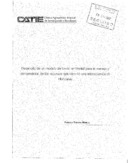Desarrollo de un modelo de fondo ambiental para el manejo y conservación de los recursos naturales de una microcuenca de Honduras
Alternative title
Development of an environmental fund model for the management and conservation of the natural resources of a watershed in Honduras
Description
Tesis (Mag. Sc.) -- CATIE, 2002 114 páginas ilustraciones, 35 tablas 21.59 x 27.94 cm. Bibliografía páginas 108-114
Abstract
En este estudio se plantea que una de las principales fuentes de ingresos para la creación de un fondo ambiental es el ecoturismo y para conocer los ingresos que esta actividad genera, se utilizó la valoración contingente para estimar la Voluntad de Pago (VDP) de los turistas nacionales y extranjeros. Al realizar la encuesta, se plantearon dos diferentes situaciones: una contribución voluntaria en la entrada de Valle de Angeles para la conservación de la microcuenca y, el pago de un boleto de entrada a un sendero. Los resultados muestran que en general, los turistas tienen una VDP positiva; sin embargo, los visitantes nacionales tienen una mayor VDP que los extranjeros. El 93 por ciento de los turistas nacionales están dispuestos a pagar Lps. 2.00 en la primera situación y el 91 por ciento pagará Lps. 10.000 por la entrada a un sendero. En cambio, sólo el 88 por ciento de los turistas extranjeros están dispuestos a pagar US 2.00 dólares para el manejo de la microcuenca y el 56 por ciento de ellos pagará US 10.00 dólares por entrar al sendero. In this study the Ecotourism is considered as one of the main economic sources for the creation of an environmental fund. The use of contingent valuation was necessary to find out the willingness to pay (WTP) of national and foreign tourists, in order to calculate the revenue of this activity. The survey used for the valuation was based in two situations: a voluntary contribution at the entrance of Valle de Angeles for the conservation of the watershed and a payment for an entrance ticket to a natural trail. The results show that tourists have a positive WTP, although national visitors have a greater WTP than foreigners. The 93 percent of national tourists have the will to pay Lps 2.00 at the first situation and the 91 percent will pay Lps. 10.00 for an entrance ticket to a natural trail. But only 88 percent of the foreign tourists have a will to pay US 2.00 dollars for the conservation of the watershed and the 56 percent of them have the will to pay US 10.00 dollars for the entrance to the trail.
Keywords
WATERSHEDS, WATERSHED MANAGEMENT, MODELS, VALUATION, PHYSIOGRAPHIC FEATURES, SOCIOECONOMIC ENVIRONMENT, TOURISM, RURAL AREAS, ECONOMIC VIABILITYHONDURAS, CUENCAS HIDROGRAFICAS, ORDENACION DE CUENCAS, MODELOS, ESTIMACION, ASPECTOS FISIOGRAFICOS, ENTORNO SOCIOECONOMICO, TURISMO, ZONAS RURALES, VIABILIDAD ECONOMICA,
Publisher
CATIE, Turrialba (Costa Rica)
URI (Permanet link to cite or share this item)
https://repositorio.catie.ac.cr/handle/11554/4780Collections
- Tesis [1392]


